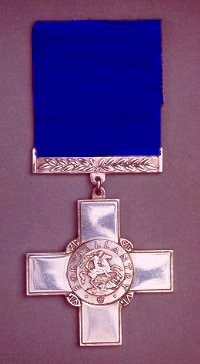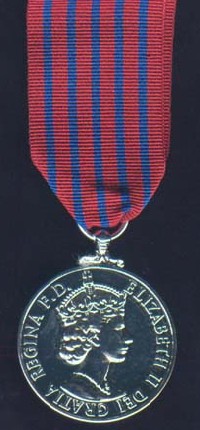British Gallantry Medals
By Stephen Sherman, Dec. 2008. Updated July 19, 2011.
These are awards for gallantry, as opposed to any particular military campaign. They include the Victoria Cross, possibly the world's most famous medal.
VICTORIA CROSS
Description: (shown upper left)
Cast in bronze in the shape of a cross the obverse of this award bears the Royal Crown of Queen Victoria in the centre upon which stands a proud lion (also wearing a smaller crown) and the inscription 'FOR VALOUR' within a pendant draped around the centre from the left to right arms of the cross. The reverse of the medal is rather plain with a raised circle border in the centre. The suspender is a straight simple one decorated with leaves with a 'V' (for Victoria) at the lower centre through which it is attached via a small metal ring to a loop on the top arm of the cross.
Clasps:
A bar for second awards is authorised for this cross.
Ribbon:
Originally the Army had a 1.5" wide dark crimson ribbon and the Royal Navy had a dark blue one. After 1920 the crimson ribbon was adopted for all services including the recently formed RAF.
Naming:
Naming is engraved on the plain reverse of the suspender while the date of the action which earned the award is engraved in the centre of the circle of the actual cross.
Notes:
The cross was instituted in 1856 and is cast (not struck) from the bronze of a Russian cannon captured during the Crimean War. The cross is made and hand finished by the well-known jewellers Messrs. Hancocks & Co., of Vigo Street, London who receive the metal from the Ministry of Defence as required. Strangely the firm does not make any other medal or award.
Because the cross is cast (not struck as with most awards) the size of original awards vary from one another as the length of the cooling process of the metal is different every time one is made. Most copies of this cross are either struck or made by a cast from an original award (making it even smaller) and collectors are unlikely to be fooled by them. However some convincing fakes have been seen on the market in recent years but since the whereabouts of most VC's is known it is extremely unlikely that any fake would be sold as an original at auction by mistake.
It is well known that the VC today is the highest of all decorations that can be won by any serviceman or woman (civilians are also eligible under certain conditions), but until 1902 this was not the case. Prior to Edward VII as King the VC was often worn either after the relevant campaign medal for which it was won or after other decorations such as Royal Victorian Order.
The next of kin of officers and men who would have won the VC but were killed during the act that would have earned the award did not receive the cross as is custom with campaign medals. However in 1902 Edward VII decreed that posthumous awards should be made for those killed during the Boer War and in 1907 this was made retrospective for others who would have won the award before that date.
When the ribbon is worn without the cross a miniature VC emblem is worn at the centre. In 1917 it was stipulated that for second awards a second miniature VC could be worn on the ribbon when the actual cross is not worn itself.
Perhaps one of the most valuable VCs of all time would be that awarded to Lieutenant John Chard of the Royal Engineers in 1879. Chard had been the officer in command of the defence of Rorke's Drift during the Zulu War which is also the battle in which the largest number of VC's (11 in total) have ever been awarded for a single action. However the whereabouts of Chard's VC is unknown and his family have only a replica.
GEORGE CROSS
Image courtesy of Royal Signals Museum
Description:
Plain cross with a circular central disc housing the effigy of St. George and the Dragon surrounded by the inscription 'FOR GALLANTRY'. Between each arm of the cross is the GVI Royal cipher while the reverse of the medal is plain and flat. The suspender is straight decorated with laurel wreaths and is attached to the cross by a small metal loop.
Clasps:
A bar for second awards is authorised for this cross.
Ribbon:
1.5" wide and dark blue.
Naming:
Naming is engraved on the plain reverse of the suspender while the date of the action which earned the award is engraved in the centre of the cross.
Notes:
Introduced in 1940 the George Cross is the highest award for civilians and members of the armed forces who conduct an act of extreme gallantry where normal military honours would not normally be granted. To this end it is often referred to as the 'Civilian's VC). This award superseded the Empire Gallantry Medal whose recipients could hand in their medals and convert to the George Cross. In December 1971 it was decided that this award would also replace the Albert and Edward Medals where again the recipients of these awards could hand them in and convert to the George Cross.
The most famous of all George Crosses is the one awarded to the islands of Malta for their heroic defence against the Germans and Italians during the Second World War. Despite heavy bombing and blockades Malta was never taken by the axis forces.
Post 1940 (i.e. non-converted awards) are the most valuable while converted awards are seen as less desirable. Either way this award is both expensive and highly collectable.
GEORGE MEDAL
Description:
The obverse of this medal bears the head of the reigning monarch while the reverse depicts St. George and the Dragon with the inscription 'THE GEORGE MEDAL'. The ribbon is attached via a metal loop fixed to the medal via a claw mount.
Clasps:
A bar for second awards is authorised for this cross.
Ribbon:
1.25" wide of crimson with 5 narrow blue stripes.
Naming:
Naming is in impressed capital letters on the medal's lower rim.
Notes:
Introduced in 1940 the George Medal is awarded for gallant acts which fall slightly short of those required for the award of the George Cross. As with the George Cross this is primarily a civilian award but armed forces personnel are also eligible for acts of bravery not in the face of the enemy. Approximately 2000 awards of this medal have been made.
Distinguished Service Order
Conspicuous Gallantry Cross
Conspicuous Gallantry Medal
Distinguished Service Cross
Distinguished Conduct Medal
MILITARY CROSS
Description:
The obverse of this cross is decorated with the imperial crown at the edges of each arm while the Royal cypher of the reigning monarch appears in the centre. The reverse is plain and the ribbon is attached via a narrow plain suspender linked to the cross with a small metal loop.
Clasps:
A bar for subsequent awards is authorised for this cross.
Ribbon:
38mm wide, white with a central dark purple stripe.
Naming:
From 1938 naming appears on the plain reverse of this cross with the date of the act which earned the award on the lower arm while awards prior to this date were made unnamed.
Notes:
Introduced in 1914 this medal was designed to fill the gap between the Victoria Cross and the Distinguished Service Order. Originally the cross was awarded only to Captains, Lieutenants and Warrant Officers of the Army (higher ranking officers still received the DSO) it was later made available to the equivalent ranks in the RAF and in 1931 the award was extended to Majors. By 1993 enlisted men as well as officers became eligible for this award replacing the Military Medal.



